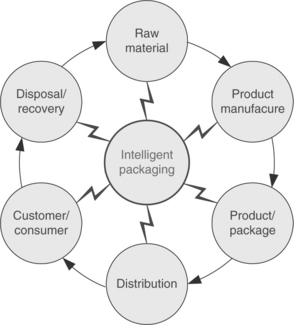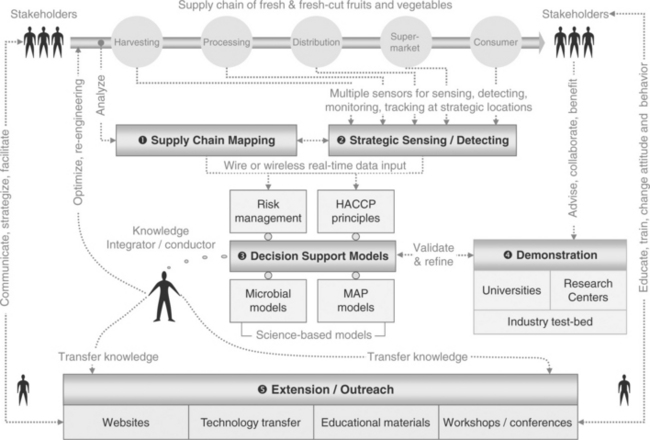Intelligent packaging to enhance food safety and quality
Abstract:
Intelligent packaging is an emerging technology that uses the communication function of the package to facilitate decision making in order to achieve the benefits of enhanced food quality and safety. This chapter introduces the basic concept of intelligent packaging and describes a conceptual framework of intelligent decision support system to minimize microbial hazards of food.
8.1 Introduction
Traditionally, the functions of packaging are classified into four basic categories: protection, communication, convenience, and containment (Paine, 1991; Robertson, 1993). Packages protect the product against the external environment, communicate with the consumer as marketing tools, make products more convenient and easier to use for the consumer, and act as containers for products of various sizes and shapes. These functions are not totally exclusive; for example, warning labels and cooking instructions, part of the communicative function, can also help to enhance food protection and convenience.
Although traditional packaging contributed greatly to the development of early food distribution systems, it is no longer sufficient since today’s society is becoming increasingly complex. Innovative packaging with enhanced functions is constantly sought after, in response to the consumer demand for minimally processed foods with fewer preservatives, more string regulatory requirements, market globalization, increased concerns for food safety, and more recently, the threat of food bioterrorism.
During the past two decades it has become clear the popularity of active packaging (Rooney, 1995; Brody et al., 2001) signifies a major paradigm shift in packaging; namely, the protection function of packaging is no longer passive, but active. Previously, primary packaging materials were considered as ‘passive’, meaning that they functioned only as an inert barrier to protect the product against oxygen and moisture. Nowadays, a host of new packaging materials have been developed that provide ‘active’ protection to food products. Controlled release packaging is an example of innovative active packaging technology.
Sections 8.2–8.4 are based on Yam et al. (2005). Material is reproduced with permission from Wiley.
Another paradigm shift that has occurred in recent years has been the progression of food packages from mediocre communicators to intelligent communicators, in other words the emergence of intelligent packaging. The uniqueness of this technology is its ability to communicate throughout the supply chain cycle to enhance food safety and quality.
8.2 Basic concepts of intelligent packaging (IP)
Intelligent packaging (IP) is defined as the science and technology that uses the communication function of the packaging system to facilitate decision making so that appropriate actions may be taken to achieve desired benefits in food quality and safety enhancement by, among other things, monitoring and improving the distribution and storage conditions. The uniqueness of IP stems from the fact that the package is the food’s closest companion: since the two move together throughout the supply chain cycle, the package is in the best position to communicate the conditions of the food. A package is ‘intelligent’ if it has the ability to communicate with people: for example, an intelligent package is one that can monitor the quality/safety condition of a food product and provide early warning to the consumer or food manufacturer. It is important to emphasize that IP is a product delivery system that involves not only the package, but also the food product, the external environment, and other considerations.
Intelligent packaging can play an important role in facilitating the flows of both materials and information in the food supply chain cycle. In Fig. 8.1, the outer circles represent the supply chain cycle from raw material through manufacturing, packaging, distribution, product use, and disposal. The package, in one form or another (such as pouch, container, drum, pallet), is traditionally used to facilitate the flow of materials (represented by the arrows in the figure) from one location to another, by performing the basic functions of containment and protection of the product. Furthermore, the package can also facilitate the flow of information (represented by the communication links between the inner circle and outer circles), although this communication function has been largely overlooked. The package can indeed be a highly effective communicator; it can carry actual information in the direction of material flow (e.g., via truck, train, or ship), and it can transmit information visually (e.g. via an indicator) or electronically (e.g., via a barcode or the Internet) throughout every phase of the supply chain cycle.
A conceptual framework describing the flow of information in an IP system is illustrated in Fig. 8.2. The system consists of four components: smart package devices, data layers, data processing, and information highway (wire or wireless communication networks) in the food supply chain. The smart package devices are largely responsible for giving birth to the concept of IP since they impart the package with a new ability to acquire, store, and transfer data. The data layers, data processing, and information highway are collectively referred to here as the decision support system.
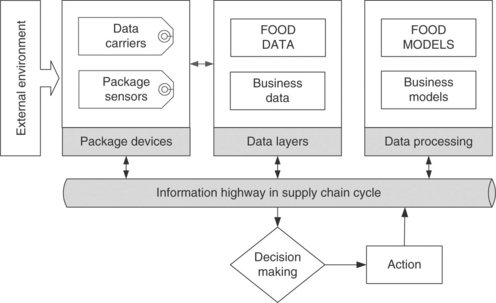
Fig. 8.2 Conceptual framework of intelligent packaging system. Reproduced from Yam et al. (2005) with permission from Wiley.
As shown in Fig. 8.2, the smart package devices and the decision support system are designed to work together to monitor changes in the internal and external environments and communicate the conditions of the food product, so that timely decisions can be made and appropriate actions taken. From the quality and safety viewpoint, the external environment can be divided into the ambient, physical, and human environments, which are factors important for determining shelf life. However, the business environment is also an important factor; in fact, the development of smart package devices (especially data carriers) and the information highway is largely motivated by the desire to increase profit or operational efficiency. Presently, business data (such as product identification, quantity, and price) and business models (rules for processing information to maximize profits) are incorporated into the system to facilitate product checkout, inventory control, and product traceability. It is interesting to note that just a decade ago, IP was not an attractive concept since package devices and computer networks were quite limited and expensive. Today, more powerful and affordable information technology has created a favorable environment for IP to flourish.
A challenging question for the food packaging scientist or technologist is whether more efficient delivery of safe and quality food products can also be achieved by superimposing an additional layer of food data and food models (capitalized in Fig. 8.2) on the information highway of the food supply chain, the goal of IP. The food data refers to data that are indicative of food quality and safety (such as time-temperature history, microbial count, pH, water activity), and the food models refer to scientific principles or heuristic rules for processing the food data to enable sound decision making. The answer to this question is likely positive, although significant research and development is needed before the potential of IP for enhancing food quality and safety could be fully realized.
8.3 Smart package devices
Smart package devices are defined here as small, inexpensive labels or tags that are attached onto primary packaging (e.g., pouches, trays, or bottles), or more often onto secondary packaging (e.g., shipping containers), to facilitate communication throughout the supply chain. There are two basic types of smart package devices: data carriers (such as barcode labels and RFID tags) that are used to store and transmit data, and package indicators (such as time-temperature indicators, gas indicators, biosensors) that are used to monitor the external environment and, whenever appropriate, issue warnings. As shown in Fig. 8.2, these devices provide a communication channel between the external environment and the other components in the system. They differ from each other not only in ‘hardware’ (physical makeup), but also in the amount and type of data that can be carried and how the data are captured and distributed. In a typical IP system, multiple smart package devices are employed at several strategic locations throughout the supply chain.
8.3.1 Barcodes
Barcodes are the least expensive and most popular form of data carriers. The UPC (universal product code) barcode was introduced in the 1970s and has since become ubiquitous in the grocery store for facilitating inventory control, stock reordering, and checkout. To enable barcodes to communicate with scanners and printers, many standards have been developed over the years into commonly accepted languages known as ‘symbologies’, although less than 20 of them are used today. The UPC barcode is a linear symbology consisting of a pattern of bars and spaces to represent 12 digits of data. Its meager storage capacity allows the containment of only very limited information such as manufacturer identification number and item number, leaving no room for encoding additional information.
As scanners are becoming more powerful and affordable, two-dimensional barcodes are also gaining popularity. The PDF 417 (where PDF stands for Portable Data File) is a two-dimensional symbol that carries up to 1.1 kilobytes of data in the space of a UPC barcode. It allows the encoding of additional information not possible with linear barcodes, such as nutritional information, cooking instructions, website address of food manufacturer, and even graphics. The advantage of portable data is that they are available immediately, without having to access an external database.
8.3.2 Radio frequency identification (RFID) tags
The RFID tag is an advanced form of data carrier for automatic product identification and traceability. Although RFID has been available for many years for tracking expensive items and livestock, its broad application in packaging has only begun in recent years. In a typical RFID system, a reader (or interrogator) emits radio waves to capture data from a RFID tag, and the data is then passed onto a host computer (which may be connected to a local network or to the Internet) for analysis and decision making. Inside the RFID tag is a minuscule microchip connected to a tiny antenna. RFID tags may be classified into two types: passive tags that have no battery and are powered by the energy supplied by the reader, and active tags that have their own battery for powering the microchip’s circuitry and broadcasting signals to the reader. The more expensive active tags have a reading range of 100 feet or more, while the less expensive passive tags have a reading range of up to 15 feet. The actual reading range depends on many factors including the frequency of operation, the power of the reader, and the possible interference from metal objects.
Compared to the barcode, the RFID tag has several unique characteristics. Line-of-sight is usually not required: that is, the RFID tag does not need to be oriented towards the reader for data transfer to occur because radio waves travel through a wide array of non-metallic materials. A significantly larger data storage capacity is available (up to 1 MB for high-end RFID tags), which may be used to store information such as temperature and relative humidity data, nutritional information, and cooking instructions. Read-write operations are supported by some RFID tags, which are useful in providing real-time information updates as the tagged items move through the supply chain. Multiple RFID tags may be read simultaneously at a rapid rate. Nevertheless, the RFID tag is generally not considered as a replacement for the barcode. Since both data carriers have advantages and disadvantages, they will continue to be used either alone or in combination, depending on the situation. A RFID tag may also be integrated with a time-temperature indicator or a biosensor to carry time-temperature history and microbiological data.
In recent years, there has been an overwhelming interest from major retailers, companies, government agencies, and researchers in using RFID tags for various applications such as supply chain management, asset tracking, security control, and feed pattern of livestocks. An impetus for this technology is that several major retailers including Wal-Mart Stores and Metro Group have issued mandates requiring their leading suppliers to use RFID tags on shipping crates and pallets. Such mandates are accelerating the adoption of the technology and further development of the RFID information highway.
8.3.3 Time-temperature indicators (TTIs)
Temperature is usually the most important environmental factor influencing the kinetics of physical and chemical deteriorations, as well as microbial growth in food products. Time-temperature indicators (TTIs) are typically small self-adhesive labels attached onto shipping containers or individual consumer packages. These labels provide visual indications of temperature history during distribution and storage, which is particularly useful for warning on the exposure of chilled or frozen food products to temperature abuses. They are also used as ‘freshness indicators’ for estimating the remaining shelf life for perishable products. The responses of these labels are usually some visually distinct changes that are temperature dependent, such as an increase in color intensity and diffusion of a dye along a straight path.
8.3.4 Gas indicators
The gas composition in the package headspace often changes as a result of the activity of the food product, the nature of the package, or the environmental conditions. For example, respiration of fresh produce, gas generation by spoiling microorganisms, or gas transmission through the packaging material or package leaks, may cause the gas composition inside the package to change. Gas indicators in the form of a package label or printed on packaging films can monitor changes in the gas composition, thereby providing a means of monitoring the quality and safety of food products.
8.3.5 Biosensors
The broad spectrum of foodborne infections is changing constantly over time as most known pathogens are controlled and new ones have emerged. There is a need for rapid, accurate, on-line sensing for in situ analysis of pollutants, detection and identification of pathogens, and monitoring of post-processing food quality parameters.
In general, a biosensor is a compact analytical device that detects, records, and transmits information pertaining to biochemical reactions. This smart device consists of two primary components: a bioreceptor that recognizes a target analyte, and a transducer that converts biochemical signals into a quantifiable electrical response. The bioreceptor is an organic or biological material such as an enzyme, antigen, microbe, hormone, or nucleic acid. The transducer can assume many forms (such as electrochemical, optical, acoustic) depending on the parameters being measured. Some important characteristics of a biosensor are its specificity, sensitivity, reliability, portability, and simplicity. This chapter relates primarily to biosensors that can be placed inside the food package or integrated into the packaging material, although there are also handheld or desktop biosensors. Presently, commercial biosensors for intelligent packaging are not available, although several prototypes are being developed.
8.4 Applications of intelligent packaging (IP) to enhance food safety and biosecurity
Intelligent packaging, especially when integrating with science-based principles, is a useful tool for tracking products and monitoring their conditions, facilitating real-time data access and exchange, and enabling rapid response and timely decision making. These qualities are essential for any food safety or biosecurity strategy. The applications of intelligent packaging in enhancing traceability systems and Hazard Analysis Critical Control Points (HACCP) systems are discussed below.
Traceability, tracking, and recordkeeping of product flow through the production process and supply chain is generally considered as key in enhancing food safety and biosecurity. The existing traceability systems vary in breadth, depth, and precision; these terms refer to what data are recorded, how far backward or forward along the supply chain the data is tracked, and how precisely the product location is pinpointed, respectively. Since tracing all information with high precision is virtually impossible, only a limited set of variables is usually traced. In tracing beef, for example, variables such as global trade item number, batch/lot number, and country of origin are recommended. However, these variables do not provide technical information about the safety and quality of the food product.
Intelligent packaging could be integrated into existing traceability systems to create more effective communication links. Barcodes and RFID tags can enable electronic recordkeeping and information sharing, especially when interfaced with external instruments capable of rapidly measuring quality attributes and monitoring food safety. For example, pH meters, water activity meters, rapid microbial detection devices, or non-destructive quality measurement instruments may be placed at strategic locations along the supply chain where they exchange data with read/write barcodes or RFID tags. Nevertheless, increasing the breadth and depth of a traceability system alone is not sufficient to improve food safety; science-based food models and user-friendly software are also required to fully utilize the additional food-related data layer available.
In recent years, HAACP has become an internationally recognized system for managing the risk associated with food safety. HAACP is a science-based system that consists of seven principles: conduct hazard analysis, determine critical control points, establish critical limits, establish monitoring procedures, establish corrective actions, establish verification procedures, and establish recordkeeping and documentation procedures. The implementation of these principles requires storing, sharing, and processing information so that timely decisions and corrective actions can be made.
Figure 8.3 outlines a system based on the conceptual framework of IP and HACCP principles for managing information flow and ensuring food safety. An important point about this system is that information is shared among multiple devices at multiple locations. Information obtained from multiple devices and multiple locations, especially when the devices are interconnected, is far more useful than information obtained from a single device and at a single location. It is generally recognized that microbial detection alone is not a complete solution to ensure food safety; however, when it is coupled with physical and chemical measurements, timely detection and correction of safety problems may be achieved more readily. The multiple devices include smart package devices coupled with sensing devices such as pH meters and water activity meters that are placed along the supply chain.
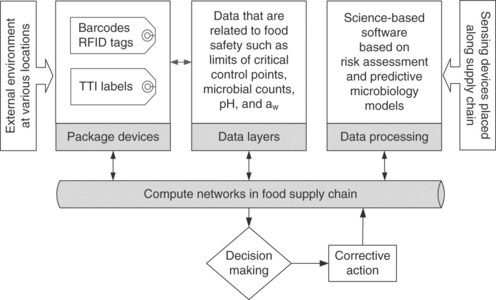
Fig. 8.3 An example of intelligent packaging and HACCP system. Reproduced from Yam et al. (2005) with permission from Wiley.
When applying the HACCP principles, special attention should be paid to designing the decision support system. The hazard analysis should determine not only the flow of materials, but also the flow of information. The critical control points, as well as the sensing devices required at specific locations, should be identified. The limits of critical control points (such as time and temperature) may be encoded in barcodes or RFID tags to enable electronic data retrieval. Monitoring of the critical control points may be achieved by using TTI labels or other sensing devices at strategic locations. Read/write RFID tags and computer networks may facilitate recordkeep-ing and documentation. Decisions on corrective actions may be facilitated using data processing software, which should incorporate science-based knowledge such as risk assessment and predictive microbiology models. The development of an IP-based HACCP system is in the early stages, and significant research work is needed for its further development and implementation.
8.5 A conceptual framework for an intelligent decision support system
To further illustrate the application of IP, Fig. 8.4 presents a conceptual framework of a science-based integrated system for minimizing microbial hazards of food.
This conceptual framework delineates the anatomy of an intelligent decision support system for minimizing microbial hazard safety of fresh produce. The term ‘decision support system’ is used to emphasize the importance of decision making, as many research/extension activities are for the purpose of making the right decisions to enable corrective actions in a timely manner. The adjective ‘intelligent’ is used to describe the sophistication of the decision-making process in this conceptual framework, which involves not only the iterative applications of the system components but also the careful interpretations of a group of well-informed experts.
8.5.1 System components
The conceptual framework consists of five interconnected components, flowing top-to-bottom from ➊ supply chain mapping to ➋ strategic sensing, ➌ decision support modeling, ➍ demonstration, and ➎ extension/outreach. The conceptual framework also clearly shows the relationships between these components (italicized hereafter), which are designed to prevent, control, or reduce contamination of pathogens in fresh produce, as well as improving communication with stakeholders to enhance food safety and mitigate public health impact should outbreaks occur.
8.5.2 Knowledge integrator/conductor
Central to the conceptual framework is the knowledge integrator/conductor, a group of people who interpret the results from decision support modeling to take corrective actions. This group will consist of researchers and decision makers of an organization or company. The words ‘integrator’ and ‘conductor’ describe the roles of integrating information and conducting activities in a concerted manner, like an orchestra conductor.
The knowledge integrator/conductor will draw information from support modeling to re-engineer and optimize the supply chain. ‘Re-engineering’ refers to applying new technology, methods, or devices (such as biosensors and integrated time-temperature sensors) to strengthen the microbial safety of the supply chain. ‘Optimization’ refers to rearrangement or manipulation of existing factors influencing the supply chain to best achieve the goal of minimizing microbial safety hazards, while satisfying the constraints imposed by practicality, economics, and people.
As shown in the conceptual framework, the knowledge integrator/conductor applies new information to re-engineer and optimize the supply chain, such as rearranging process steps or placing sensors in different locations. With the improved supply chain, supply chain mapping (component ➊), strategic sensing (component ➋), and decision support modeling (component ➌) will once again take place; this iterative process will stop only when an optimum is achieved, but will resume if the supply chain changes significantly due to market conditions.
8.5.3 Supplying chain mapping
Supply chain mapping is component ➊ in the conceptual framework. The food supply chain involves many steps from harvesting to processing, distribution, retail, preparation and consumption. While the flow of the supply chain for fresh produce is generally known, the food industry has realized that a greater understanding of the full spectrum of supply and distribution channels is necessary to address the growing challenges to food safety.
The objective is to identify critical control points which can be monitored by the devices deployed in strategic sensing and to provide vital information for decision support modeling. Guiding principles such as HAACP and life-cycle analysis of pathogens may be used to map the supply chain. The seven steps in HACCP were listed in Section 8.4. Life-cycle analysis involves analyzing the source, growth, and survival of fresh produce related pathogens.
Some specific tasks are as follows:
• Investigate all possible routes of introduction of foodborne pathogens into the produce environment at all levels of the food chain (production, processing, packaging, transportation, storage, distribution, preparation, and consumption) to identify critical control points (CCPs) which can be monitored by sensing devices.
• Identify behavior changes which are important factors influencing the risk of microbial hazards. This socio-technical analysis involves understanding how ‘as is’ behavior at various stages in the food supply chain can be transformed into ‘ideal’ behavior on the part of all stakeholders.
• Investigate various management drivers such as inventory, facilities, transportation, information, sourcing, and pricing as a means of providing structural aspects for the process mapping. The creation of the process flow diagram will facilitate the identification of hazards and CCPs at various stages of the food supply chain.
• Gather data or information for constructing the decision support system.
The supply chain mapping task will be consistent with the systematic approach of risk assessment that involves hazard identification, exposure assessment, hazard characterization and risk characterization. Such an applied science-based approach to risk assessment underpins a policy-based risk management process and enhances national and regional risk communication by supporting an interactive dialogue of the risks and possible mitigations at various stages in the food supply chain.
8.5.4 Strategic sensing
Strategic sensing is component ➋ in the conceptual framework. In this proposal, ‘sensing’ refers to sensing the presence of foodborne pathogens, or sensing the conditions of factors influencing the persistence and survival of pathogens in food, including time-temperature, pH, water activity, appear ance, and other food attributes. ‘Strategic’ means placing various sensors at strategic locations, critical control points identified from supply chain mapping (component ➊), to provide real-time data input to decision support models (component ➌). ‘Real-time data input’ means transmitting data with minimal time delay, via wire or wireless connections.
The objective is to further develop promising sensing technologies, making them more accurate, powerful and economical, and integrating them smoothly into the conceptual framework to enhance the microbial safety of food.
An important concept in the conceptual framework is that multiple sensors (biosensor, time-temperature sensor, etc.) will be strategically placed at critical points along the supply chain. These may include small sensors placed onto the food package, handheld sensors used in the field, and bench-top sensors for microbial detection. This multi-sensor platform, coupled with the decision support system, is far more effective and reliable than a single ‘silver-bullet’ sensor.
8.5.5 Decision support modeling
Decision support modeling is component ➌ in the conceptual framework. For the purposes of this chapter, a decision support system is defined as a computer information system that combines decision analytic models and database access in order to assist the decision maker in choosing the best course of action. Figure 8.5 depicts a strategy for decision support modeling. The objective is to apply both science-based models and empirical risk management models to process data obtained from the supply chain mapping and the strategic sensing/detecting, thereby providing useful information for the knowledge integrator/conductor to make intelligent decisions and actions.
Examples of science-based models include the microbial predictive models, such as transfer (or cross-contamination) and growth models. The transfer model may predict the pathogen transferred among process equipment or steps. The growth models can show the potential growth of a specific pathogen under different conditions, such as temperature, pH, and water activity. The growth models can further take into account factors including modified atmosphere conditions, transportation, distribution, supermarket, and consumer abuses. A microbial transfer model can then be applied to estimate the quantity of contaminated products, followed by the growth model to predict the potential pathogenic health hazards. With all information collected and available in the decision-making models, an action/decision will be made or served as a feedback to further enhance the inspection steps (e.g. HACCP) in the entire production/distribution loop to achieve the microbial safety targets.
Figure 8.6 shows an example of a risk management model, which is a framework to capture the interactions of organizational, task/environmental and individual risk factors leading to a mishap or an adverse event. There is both an active pathway from the organization to task/environment to the individual as well as a latent pathway based on the existing preconditions for a mishap. Despite the best of intentions, sometimes defenses, such as procedures, hardware, and/or software may be breached and mishaps will occur. In the food industry, an adverse event will most likely lead to lost sales. These lost sales will lead to mitigations or interventions in the food supply chain which are intended to lead to changed behavior. This changed behavior is intended to reduce the likelihood of occurrence of various organizational, task/environmental, and individual risk factors.
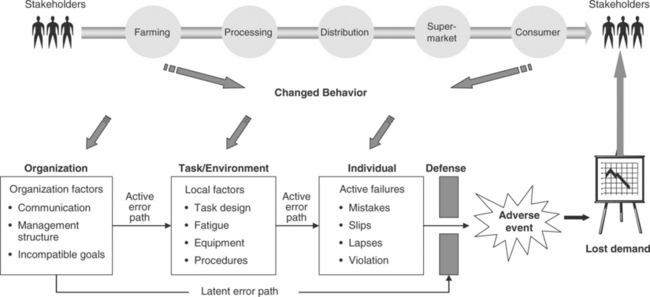
Fig. 8.6 Model adapted for food safety risk management. (adapted from Reason, 1995)
8.5.6 Demonstration and extension/outreach
Demonstration is component ➍ in the conceptual framework and involves universities, research institutes, and industry working together to validate the technologies in real-world supply chains. Extension/outreach (component ➎) involves strong interactions between the knowledge integrator/ conductor and the stakeholders. The objective is to communicate science-based knowledge and technologies gained from this work to markedly improve stakeholders’ ability and behavior to manage food safety issues.
8.6 Conclusions
Intelligent packaging is emerging as a new branch of packaging science and technology that offers exciting opportunities for enhancing food safety, quality, and convenience. For this technology to advance, researchers will be required to continue to think outside the box and use non-traditional packaging approaches to meet challenges. For the first time, packaging science, food engineering, biotechnology, information technology, nano-technology, and other disciplines are coming together to develop a breakthrough packaging technology. As this technology is unfolding, issues such as those relating to legislation and consumer acceptance also need to be addressed.
8.7 References
Brody, A.L., Strupinsky, E.R., Kline, L.R. Active packaging for food applications. Lancaster, PA: Technomic Publishing; 2001.
Paine, F.A.The packaging user’s handbook. New York: AVI, Van Nostrand Reinhold, 1991.
Reason, J. A system approach to organizational error. Ergonomics. 1995; 38(8):1708–1721.
Robertson, G.L. Food packaging: principles and practice. New York: Marcel Dekker; 1993.
Rooney, M.L. Active food packaging. New York: Blackie Academic & Professional; 1995.
Yam, K.L., Takhistov, P.T., Miltz, J., Intelligent packaging: concepts and applications. Journal of Food Science 2005; 70:R1–R10, doi: 10.1111/j.1365-2621.2005.tb09052.x. [Wiley, Chichester].

